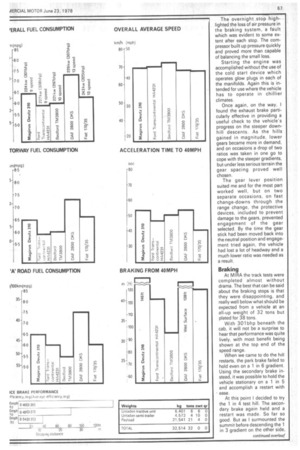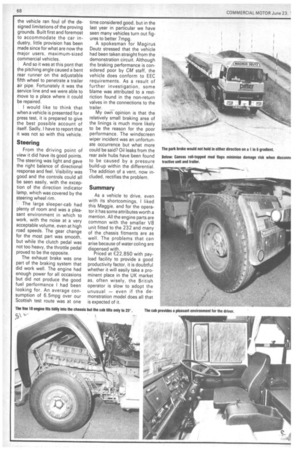Niggling points
Page 67

Page 69

Page 70

If you've noticed an error in this article please click here to report it so we can fix it.
and poor braking spoil Maggie
CM road rest by 1311 Brock-Hc-ures by Mike Loveridge
maximum speed.
Little wind and a fair sky for all but the first part of the day, made for ideal conditions, but traffic conditions were less agreeable. Road works near the start of the route on the M1 delayed us for nearly 10 minutes.
The first stop, unscheduled, came only 30 miles from the start point when it became necessary to remove the nearside windscreen wiper blade and arm, which had quite suddenly become entangled with the rearview mirror. The splines on the drive head had sheared as a result, and it was not practical just to reposition it. Once on the move again, the remaining two blades cleared a good area of the screen, so that forward vision was not greatly impaired.
Once off the motorway and on to the A5, the flexibility of the engine became more apparent. Again we were delayed by road works, with the result that by the time we reached Forton for lunch, we were recording only about average progress, and so it remained until the end of the day.
A rudimentary check of the vehicle, at the start of the second day, showed that oil was seeping from the hub of the rear axle but not enough at this stage to detain us.
In-cab comfort Although it was a cold morning the cab was soon warmed by a Webasto oil-fired heater operating independently of the engine. I can imagine that drivers on cold Continental runs consider them a must.
Although a costly item, about £600 fitted, it is standard equipment on the 310. It can be used while the vehicle is in motion, but was not needed once the engine had reached its optimum temperatures. In the absence of water cooling, it is the engine oil from which the radiated heat is taken. The vehicle heater controls were not so ideal. With engine oil temperatures ranging from BO' to 120F, constant adjustment was needed to maintain a comfortable setting.
continued overleaf
The overnight .stop highlighted the loss of air pressure in the braking system, a fault which was evident to some ex tent after each stop. The compressor built up pressure quickly and proved more than capable of balancing the small loss.
Starting the engine was accomplished without the use of the cold start device which operates glow plugs in each of the manifolds. Again this is in tended for use where the vehicle has to operate in chillier climates.
Once again, on the way, I found the exhaust brake parti cularly effective in providing a useful check to the vehicle's progress on the steeper down hill descents. As the hills gained in magnitude, lower gears became more in demand, and on occasions a drop of two ratios was taken in one go to cope with the steeper gradients, but under less serious terrain the gear spacing proved well chosen.
The gear lever position suited me and for the most part worked well, but on two separate occasions, on fast change-downs through the range change, the protective devices, included to prevent damage to the gears, prevented engagement of the gear selected. By the time the gear stick had been moved back into the neutral position and engagement tried again, the vehicle had lost a lot of headway and a much lower ratio was needed as a result.
Braking
At MIRA the track tests were completed almost without drama. The best that can be said about the braking stops is that they were disappointing, and really well below what should be expected from a vehicle at an all-up weight of 32 tons but plated for 38 tons.
With 301bhp beneath the cab, it will not be a surprise to hear that performance was quite lively, with most benefit being shown at the top end of the speed range.
When we came to do the hill restarts, the park brake failed to hold even on a 1 in 6 gradient. Using the secondary brake instead, it was possible to hold the vehicle stationary on a 1 in 5 and accomplish a restart with • ease.
At this point I decided to try the 1 in 4 test hill. The secondary brake again held and a restart was made. So far so good. But as I surmounted the summit before descending the 1 in 3 gradient on the other side, the vehicle ran foul of the designed limitations of the proving grounds. Built first and foremost to accommodate the car industry, little provision has been made since for what are now the major users, maximum-sized commercial vehicles.
And so it was at this pont that the pitching angle caused a bent rear runner on the adjustable fifth wheel to penetrate a trailer air pipe. Fortunately it was the service line and we were able to move to a place where it could be repaired.
I would like to think that when a vehicle is presented for a press test, it is prepared to give the best possible account of itself. Sadly, I have to report that it was not so with this vehicle.
Steering
From the driving point of view it did have its good points. The steering was light and gave the right balance of directional response and feel. Visibility was good and the controls could all be seen easily, with the exception of the direction indicator lamp, which was covered by the steering wheel rim.
The large sleeper-cab had plenty of room and was a pleasant environment in which to work, with the noise at a very acceptable volume, even at high road speeds. The gear change for the most part was smooth, but while the clutch pedal was not too heavy, the throttle pedal proved to be the opposite.
The exhaust brake was one part of the braking system that did work well. The engine had enough power for all occasions but did not produce the good fuel performance I had been looking for. An average consumption of 6.5mpg over our Scottish test route was at one time considered good, but in the last year in particular we have seen many vehicles turn out figures to better 7mpg.
A spokesman for Magirus Deutz stressed that the vehicle had been taken straight from the demonstration circuit. Although the braking performance is considered poor by CM staff, the vehicle does conform to EEC requirements. As a result of further investigation, some blame was attributed to a restriction found in the non-return valves in the connections to the trailer.
My own opinion is that the relatively small braking area of the linings is much more likely to be the reason for the poor performance. The windscreen wiper incident was an unfortunate occurrence but what more could be said? Oil leaks from the rear axle hubs have been found to be caused by a pressure build-up within the differential. The addition of a vent, now included, rectifies the problem.
Summary
As a vehicle to drive, even with its shortcomings, I liked this Maggie, and for the operator it has some attributes worth a mention. All the engine parts are common with the smaller V8 unit fitted to the 232 and many of the chassis fitments are as well. The problems that can arise because of water coling are dispensed with. Priced at £22,850 with payload facility to provide a good productivity factor, it is doubtful whether it will easily take a prominent place in the UK market as, often wisely, the British operator is slow to adopt the unusual — even if the demonstration model does all that is expected of it.




































































































































































